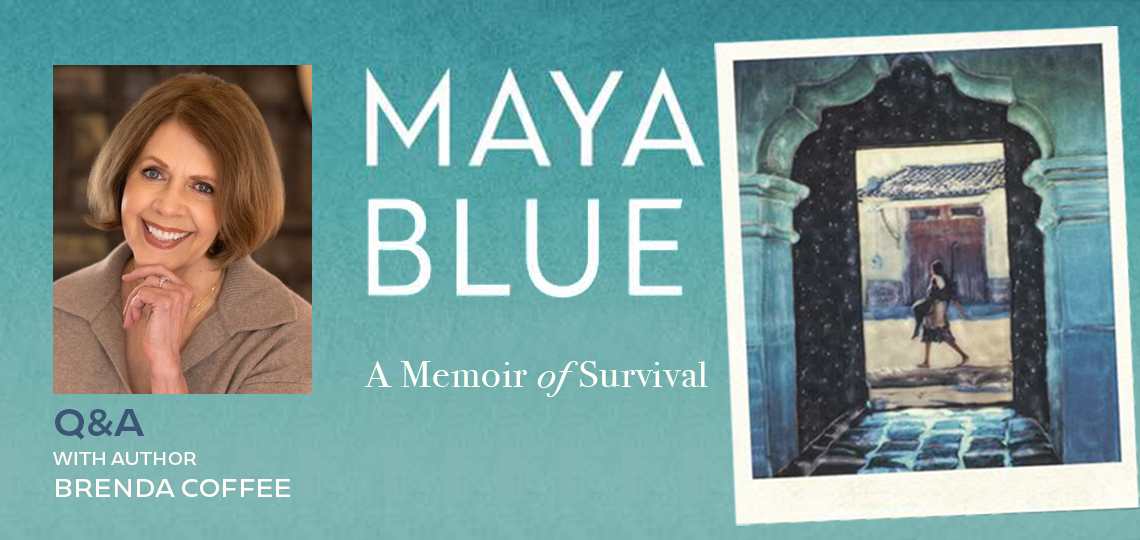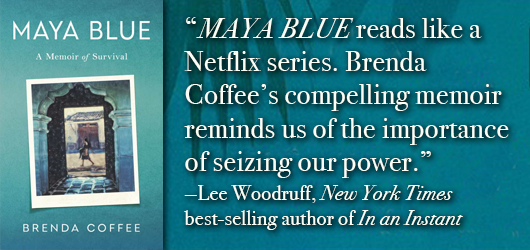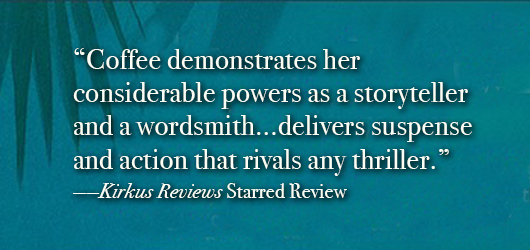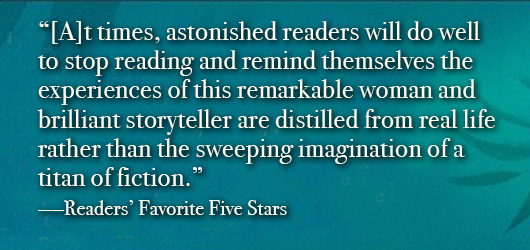"A memoir that reads like a thriller"

Executive Editor Matt Sutherland Interviews Brenda Coffee, Author of Maya Blue: A Memoir of Survival
A memoir that reads like a thriller, Brenda Coffee’s Maya Blue reminds us of the power of our voice and speaking our truth. It is Working Girl meets Taken and, in the end, she’s the last one standing. “Maya Blue” references a stunning blue pigment used by the ancient Maya, one that has proven to be the strongest, most resilient pigment known to man—drawing the perfect analogy for Brenda’s enduring strength through all manner of challenges.
We recently discovered Maya Blue through a favorable Foreword Clarion review and quickly assigned Executive Editor Matt Sutherland to connect with Brenda for the following conversation.
Maya Blue picks up your life in your thirties during the later stages of your marriage to Jon Philip Ray, inventor of the first personal computer and the microprocessor. On page one, you write that a big threatening guy knocks on your door and says he has it on good authority that whoever lives there needs a bodyguard, and they better watch their step. What did you interpret that to mean?
My husband and I interpreted it as a threat, as did our corporate attorneys who hired the sniper on the San Antonio SWAT squad as our bodyguard. At the time, my husband had invented the first smokeless cigarette. I coined the terms vape and vaping. The vape was a revolutionary product because it contained only nicotine. Nicotine is capable of vaporizing all by itself, so the vape didn’t need a battery or to be lit with a match. While nicotine is addicting, it doesn’t cause cancer, and the vape didn’t have any of the 2,000 cancer causing byproducts of burning like traditional cigarettes. And since it had no offensive smoke, you could use it anywhere cigarettes were banned. We always thought Big Tobacco would try somehow to stop us, but we never dreamed they would threaten our lives and repeatedly break into our home.
Why do you think they wanted to break into your house and perhaps hurt you?
It was all about the money. Big Tobacco earns billions—now trillions—of dollars a year in revenue from the sale of traditional cigarettes, and if the vape sold well, it could have significantly reduced their revenue stream. But it was even more sinister than that. The vape didn’t meet the legal definition of a cigarette, which meant the federal government couldn’t tax it, and the tax on cigarettes is the government’s second largest revenue source—our income tax is the first. So like Big Tobacco, the government stood to lose billions in revenue as well. For that reason, the feds and Big Tobacco have looked the other way about the dangers of a product that’s killing its customers. Nicotine is the only alkaloid (morphine, heroin, opium, cocaine) that isn’t classified as an addicting drug and controlled by the FDA.
At the time, we were a publicly held company. The former president of RJ Reynolds International was our VP of marketing, so we had inside information. We knew it was a matter of time before they made a move to stop us, but we never dreamed they would threaten our lives and repeatedly rifle through my lingerie drawers, my office, and Philip’s lab. In the middle of the night, I heard them outside our bedroom door—men in dark slacks who’d overridden our alarm system, not punks in blue jeans who’d busted open a window to steal a stereo. I confronted them with a shotgun, and they fled down the stairs and out the door. It was a scary way to live.
This sounds a bit like The Insider, with Russell Crowe. Wasn’t that movie about the tobacco industry?
Yes. The Insider was in 1999, and it’s another true story based on a Vanity Fair article and a 60 Minutes piece about Dr. Jeffrey Wigand, former vice president of R&D for Brown & Williamson Tobacco. Dr. Wigand and his family’s lives were threatened, bullets left in their mailbox, and they went into hiding because he blew the whistle on the tobacco industry. Big Tobacco knew their product was addicting, but they added harmful ingredients to make cigarettes even more addicting. We both lived through a similar nightmare, and Dr. Wigand wrote a book blurb for Maya Blue. He’s suggested we go on a speaking tour together because nothing’s changed with the cigarette industry, plus today’s vapes are almost as harmful as cigarettes, and they target a younger user.
At the same time all of this was going on, your husband was also making synthetic cocaine in your basement. How did that come about and how did you feel about it?
Philip was a brilliant scientist/entrepreneur, but for his mental health, he needed a break from starting another public company. He wanted a one-man project where he didn’t have to manage eccentric engineers and nervous investors. After reading a *Time *magazine cover story about cocaine, the dangers posed by the drug lords, and smuggling it up from South America, he wondered if anyone had made it from scratch, which would have bypassed all those problems. What began as analytical problem solving out loud, and then what I thought of as busywork until he was ready to reenter the business world, turned into an around-the-clock nightmare.
He was downstairs in the lab for over a year before he actually made cocaine. He had to teach himself organic synthesis chemistry. For me, it was like watching paint dry. He was always working down there, and I didn’t think he would actually do it, but he did. Once he knew he’d made real cocaine, he wanted to try it and see why people died in order to have it. I kept asking him to stop and shut down the lab, but I couldn’t get through to him. He’d become addicted and was drinking copious amounts of alcohol to bring himself down. He would become violent, another person I didn’t recognize, and I was terrified, but by then, he was an addict and couldn’t hear what I was saying.
When you find yourself dealing with your husband’s cocaine-and-vodka-fueled mania, you become “Ramborella”—part Rambo and part Barbarella, as a friend described you—to survive. As you write in your prologue, “It was a fairy tale until it wasn’t.” With your young, perhaps impressionable, readers in mind, can you talk about some of the signals you might have missed early in your relationship with Philip that might have foreshadowed the difficulties of your marriage?
He was thirteen years older that I was, and I wanted to please him. To impress him. Whenever there was a red flag, I swallowed my voice. I told myself I was brave and adventurous. A sophisticated mate for a worldly man. I wanted to be more than just arm candy. I wanted to be the only woman he would ever want.
Life was exciting. We raced cars for nine years, dug for minerals and crystals in abandoned silver mines, and explored the jungles in the Yucatan for unexcavated Maya ruins. We were Indiana Jones before there was an Indiana Jones. I look back at my younger self with compassion and sometimes with my mouth agape. I’m lucky to be alive, but more than that, it makes me sad to think how close I came to losing myself. How I did things not because I wanted to—things that weren’t in my best interest—but because I wanted to be loved. If I could impart one word of advice it would be to never lose your voice. It’s the strongest power we have.
Philip eventually died of lung cancer, but your nightmare wasn’t over. You head off for a “carefree week” to visit Mayan ruins in Guatemala—but a most horrible thing happens to you when your taxi is stopped by the Guatemalan army. You were taken at gunpoint by the most evil men imaginable. Can you talk about the courage you were able to muster and where you think it came from?
Earlier in my life, my mother had a nervous breakdown. When I was twelve or thirteen, we role-reversed, and I learned how to remain calm in a crisis and be in charge. During my life with Philip, that quality became even more important—knowing how to react in dangerous situations. In the jungle, I knew I couldn’t panic and fall apart. I had to keep my head and look for an opportunity to get away, which I did. It was only after I escaped and returned home that I started researching the men who took me. According to the United Nations, they’re responsible for murdering 200,000 people and another 45,000 became what they refer to as “the disappeared,” Los Desaparecidos. By then, I had a serious case of what we now call PTSD. A friend suggested a great therapist who specialized in self-hypnosis or Guided Imagery, and I worked with him for years. I’d hate to think where I’d be if we hadn’t met.
Please tell us about your blog and how it has strengthened you and your writing career?
My degree is in journalism and film, and I’ve worked at both, but blogging every week has enabled me to get to the point immediately. It’s more than the journalist’s “who, what, where, when, and why” questions. I’m good at starting in the middle of the action which makes what you’re reading more interesting. Right away, the reader understands what’s at stake. For years I had the “Top Breast Cancer Blog,” and now I have a “Top 10 Blog for Women Over 50.” Together, my readers and I have created a great community where they know and trust me, and they’ve gotten to know one another as well. I don’t want to sound corny, but it’s been rewarding, and I adore them. They’re my biggest cheerleaders. For years they’ve urged me to write a book, but they know nothing about Maya Blue. I’m eager to get their feedback.
How is your life now and what’s next for you?
Right now, I’m busy with PR for Maya Blue, and I’d like to make a binge-worthy limited series TV deal happen, so if any of your readers have connections, I’d be grateful if they’d contact me through either my author website or 1010ParkPlace. I have another memoir in mind, but until I find a home for Maya Blue, it’s on the backburner.
Matt Sutherland



